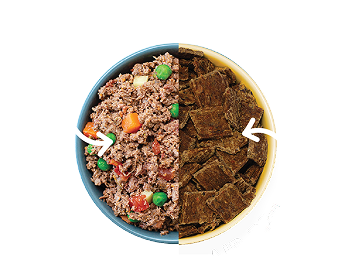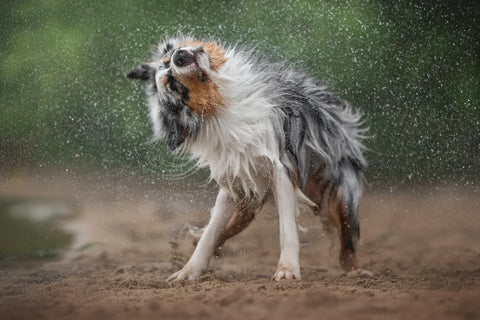
Dog Anatomy: Get To Know Your Pup From the Inside Out
Embarking on a journey into the world of canine anatomy is like unlocking a secret code that helps us understand our dogs from the inside out. At A Pup Above, we're all about nurturing that deep, intuitive relationship between dogs and their humans.
Just as we carefully select every ingredient in our meals to promote your pup's health and happiness, getting to know the intricacies of their anatomy enhances how we care for them, ensuring every wag, bark, and leap is powered by well-being.
Join us as we explore the remarkable structure and function of dogs' bodies, revealing not just the “how” but the “why” behind their every move.
Why Understand Your Pup's Anatomy, Anyway?
Getting to grips with your dog's anatomy might sound a bit like a biology lesson you never signed up for, but trust us, it's one of the coolest ways to up your pet parent game.
Here's the scoop on why knowing a bit more about what makes your dog tick is a pretty big deal:
- Spotting the Signs: Imagine being able to notice if something's off with your pup before it becomes a big issue. Knowing a bit about their anatomy helps you catch those early signs that something isn't quite right.
- Speaking Dog: Ever wish you could understand what your dog's trying to tell you? Getting familiar with their anatomy lets you read their body language like a pro, so you can figure out what they need when they need it.
- Tailoring Their Care: Just like each dog has its own personality, they also have their own physical needs. Understanding their anatomy means you can customize their workouts, their diet, and how you spoil them so they're always feeling top-notch.
- Building That Bond: There's nothing like the bond between a dog and their human. When you take the time to learn about their anatomy, it's like telling your dog, "I've got you." And that's a pretty powerful message.
So, while we might not be diving into dog anatomy to become vets, a little knowledge goes a long way in keeping our dogs happy, healthy, and hugging us for years to come.
What Exactly Does “Dog Anatomy” Mean?
When we talk about dog anatomy, we're really diving into the blueprint of how a dog is put together. It's all the bits and pieces — from their wagging tails to their sniffing snouts — that make up your dog.
Here’s a quick rundown of what’s included:
- Skeletal Structure: This is the framework of your dog, made up of all those bones that give them their shape and support their body.
- Internal Organs: Think of these as the control center for your dog’s body, keeping everything from their heart to their stomach running smoothly.
- Musculoskeletal System: This combo of muscles and bones lets your dog leap for their favorite toy or curl up in a cozy ball on the couch.
- Senses: Dogs have some pretty incredible senses, including their sharp eyesight, remarkable hearing, and an extraordinary sense of smell.
- Body Systems: We're talking about the network of systems that handle everything from breathing to digesting that tasty treat.
Each part of a dog's anatomy has a special role to play in their day-to-day adventures. Whether it's how they move, process their food, or even experience the world around them, these aspects can shine a light on just how amazing our dogs are.
Skeletal Structure
The skeletal structure of a dog is a marvel, comprising over 300 bones that not only support the body but also protect internal organs. This bony framework allows for the incredible range of motion dogs enjoy. The spine, ribs, and skull are central components, each designed for specific functions — from protecting the brain to facilitating breathing and movement.
The variety in the skeletal structures across breeds explains the vast differences in size and shape. Each breed's skeleton is adapted to its lifestyle and historical roles, from the slender whippets to the stocky bulldogs.
Internal Organs
Dogs' internal organs are the unsung heroes working tirelessly behind the scenes. Key players include the heart, the lungs, the liver and kidneys, and the stomach and intestines.
These organs are part of larger systems, each with a critical role in maintaining health. For instance, the liver's ability to detoxify is as crucial as the heart's role in circulating blood, showcasing the complexity and efficiency of a dog's internal anatomy.
Musculoskeletal System
The musculoskeletal system is where the magic of movement happens. This system is a collaboration between muscles and bones, empowered by joints, tendons, and ligaments. It's what enables your dog to run, jump, and wag their tail with joy.
Muscles attach to bones, pulling on them to create movement, while joints like the hips and shoulders provide the range of motion necessary for running and leaping. The health of this system is vital for a dog's mobility and quality of life, underscoring the importance of regular exercise and proper nutrition.
Senses
Dogs experience their world predominantly through their senses, and they are equipped for the task. Their sense of smell is legendary, allowing them to detect scents we can't even begin to perceive. Their hearing is incredibly acute, picking up frequencies beyond human capacity.
And while their sense of sight is different from ours — better at detecting movement than fine detail — it plays a crucial role in their interaction with their environment. Touch and taste also contribute to their sensory experience, helping them navigate and understand the world around them.
Body Systems
The body systems of a dog are a network of interrelated components working in harmony to sustain life.
This includes:
- The cardiovascular system pumping blood to deliver oxygen and nutrients
- The respiratory system enabling the exchange of oxygen and carbon dioxide
- The digestive system breaking down food into absorbable nutrients
- The nervous system processing information from the senses and sending out responses
Each system relies on the others, a testament to the intricate design of canine anatomy.
Tips To Support Healthy Dog Anatomy
To keep your pup's anatomy in top-notch condition, consider these simple yet effective strategies:
- Regular Exercise: Like us, dogs need regular physical activity to keep their musculoskeletal system strong and heart healthy. Tailor activities to your dog's breed, size, and age.
- Routine Check-Ups: Regular visits to the vet can catch any potential issues early, ensuring your dog's internal systems are functioning smoothly.
- Balanced Diet: A nutritious, balanced diet is crucial. Our fresh, human-grade dog food is packed with the right mix of nutrients to support every part of your dog's anatomy — from bones to internal organs and everything in between.
- Mental Stimulation: Keep your dog's mind sharp with puzzle toys and training. A stimulated mind supports a healthy nervous system.
- Proper Grooming: Regular grooming supports skin and coat health while also giving you the chance to check for any unusual signs or changes in your dog's body.
Conclusion
At A Pup Above, we're committed to more than just mealtime. We're dedicated to supporting the overall well-being of your dogs.
Understanding your dog's anatomy and taking steps to care for it can lead to a happier, healthier life together. Through exercise, regular vet visits, mental engagement, proper grooming, and, of course, nutritious, human-grade meals, you can ensure your pup thrives.
Here's to celebrating every aspect of our dogs, inside and out, and to the deep, loving bond that makes every moment with them so special.
Sources:
Is my dog sick? Try this at-home exam | The Humane Society of the United States
Understanding Dog Body Language: Decipher Dogs' Signs & Signals | American Kennel Club (AKC)
Dogs' Dazzling Sense of Smell | NOVA | PBS
Description and Physical Characteristics of Dogs - Dog Owners | Merck Veterinary Manual
Top Stories

Why Do Dogs Lick Their Paws?

Why Do Dogs Whimper & Make Noises in Their Sleep?

Healthy Vet-Approved Homemade Dog Food Recipes

How To Cook Sweet Potatoes for Dogs






















